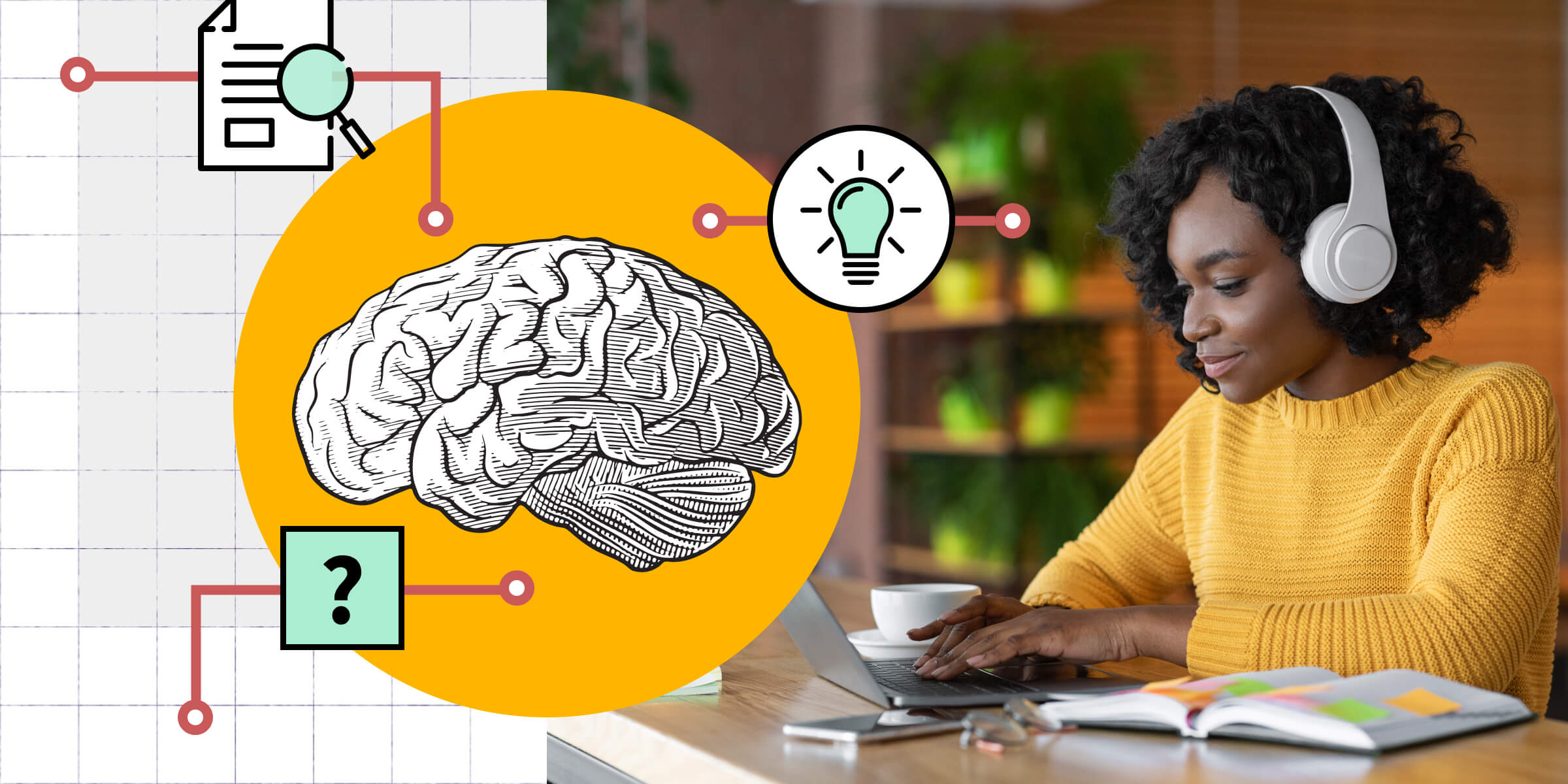Metacognition plays a critical role in the education process. The concept itself amounts to ‘thinking about thinking.’ When students learn through metacognitive activities before, during and after class, their grades or scores often improve. The reason? Self-awareness, reflection and critical thinking lead to more engagement in the classroom. As such, metacognition is one of the most important strategies that instructors, particularly college-level instructors, can use to help their students succeed.
Table of contents
- Why is metacognition important?
- Examples of metacognitive strategies
- The value of metacognition in post-secondary courses
- 8 metacognitive strategies to use in college classes
- Metacognition in the college classroom
Why is metacognition important?
Metacognition, put plainly, is thinking about one’s thinking. It refers to the processes used to plan, monitor, analyze and assess one’s understanding and performance. In other words, metacognition in the classroom is the act of considering one’s own learning and thought processes to see if those processes produce results. When educators use metacognitive strategies, learning becomes more visible for students. In turn, students gain a better understanding of why a particular strategy will help them solve a problem. Here’s an example: after an assessment, ask your students to reflect on which of the study strategies they used were most effective to plan more strategically for their next assessment to ensure they meet their learning goals on their next assessment.
The word metacognition is an umbrella term: Thinking about and analyzing one’s own thinking and learning processes happen in a number of ways, each contributing to the development of metacognition skills. You could provide students with opportunities for reflection, encourage them to engage critically with course readings or provide real-world case studies to extend learning outside the classroom. Effective educators teach their students how to use a variety of methods to measure and critically reflect on their own learning experiences.
Examples of metacognitive strategies
Practicing metacognition can help students develop the essential skill of self-regulation. In turn, students will have a deeper sense of agency over their learning. Metacognitive strategies are usually categorized into four stages: You, Plan, Do and Review.
- The ‘You’ stage is where students reflect on their prior knowledge on a topic
- The ‘Plan’ stage is where students develop an action plan for completing a task and determine the metacognitive strategies they’ll use
- The ‘Do’ stage is where students carry out a task and monitor their progress along the way
- The ‘Review’ stage is where students reflect on their learning paths and identify areas to improve when taking on completing future activities
Dr. Linda Nilson, Director Emeritus of Teaching Effectiveness and Innovation at Clemson University and author of Creating Self-Regulated Learners, highly encourages faculty to tap into metacognitive strategies in the classroom. Dr. Nilson suggests asking students the following questions to help them reflect upon their own learning process. Here’s how she recommends breaking things down:
| Planning before a task | Monitoring during a task | Evaluating after a task |
|---|---|---|
| What do I already know about the topic? | What material am I having trouble understanding? | Can I see and organize the relationship between topics? |
| What additional information, if any, will I need before completing this task? | How does what I am learning relate to what I already know? | What can I recall and what do I need to review? |
| What are my weaknesses and how can I make up for them? | How is my thinking on the topic changing? | What questions do I need to bring to the next class? |
We’ve rounded up more metacognitive strategies to help students turn into conscious learners. Get access to our free template of self-regulation activities featuring Dr. Nilson’s ideas to deepen learning. Simply sign into Top Hat or create your account today.
The value of metacognition in post-secondary courses
Through metacognitive learning strategies, students don’t just consider how they’re learning—they actually learn to identify their own strengths and weaknesses. This allows them to shore up areas where they feel confident and work more effectively on where they may need to focus future learning efforts.
It is critical for college students to understand how to use metacognitive activities to further their understanding of coursework. Students in higher ed are expected to be able to formulate independent thoughts about the subjects they’re studying. Metacognition is the first step to making this happen. Once students know what they’re thinking about a particular subject, they can make connections between their prior knowledge and the new course concepts they’re learning.
Metacognition also helps students develop a critical eye. According to Vanderbilt University, students who lack metacognition skills may lack the ability to discern the truth of what they see and hear every day—which is crucial as today’s students have more access to information than ever before. As such, the development of metacognitive skills also contributes to the growth of critical judgment skills. For this reason, it’s essential that college instructors give students plenty of opportunities to work on activities to develop metacognitive thinking. It isn’t an exaggeration to say that, for students, learning how to think is just as if not more important than the subjects they’re learning. That’s because developing metacognitive awareness can be useful for students across disciplines and beyond.
When students get a grasp on how to use metacognitive processes, they learn how they learn, and that’s a skill that transfers not only to other classes but to life outside of academia. Once students graduate, knowing how to learn is an immensely useful skill to have. This helps students become more effective learners and obtain new skills more easily, which can help meet academic, personal and professional goals.
Such practices can ultimately help students better master their lives. Students who know how to think about their own thoughts can answer questions like: What does my best life look like? Or what makes me feel good about myself?
8 metacognition strategies to use in college classes
The following eight examples offer instructors some teaching strategies and tools for employing metacognitive activities in the classroom. Each exercise is designed to allow students to think about their thinking in some way.
It’s important for instructors to remember that activities designed to promote metacognitive knowledge should be used regularly in the classroom. Sporadic use of these exercises doesn’t promote the intellectual growth that college-level students need in order to succeed in their advanced studies.
1. Let students know the purpose of in-class questions
Part of getting students on board with the process of metacognition is to help them identify when they are thinking about their thinking. If an instructor is using questions designed to elicit specific outcomes, then it’s helpful for that instructor to point out when those types of questions are being used as a form of explicit instruction. One obvious place to point out the possible use of such questions is in the syllabus.
In other words, if questions are designed to encourage students to think about their own thinking and to spark more engaged discussions, then that should be explicitly acknowledged early on.
2. Consider facilitating a diagnostic assessment
This recommendation goes hand-in-hand with point one above. At the outset of a college course, it is often a good idea for the instructor to test students on their knowledge of a given topic.
A set of ten to 20 questions about the subject gives the instructor an at-a-glance look at what students know at the beginning of the semester. The information from these quizzes can later be compared to student answers at the end of the semester. This helps instructors and students measure growth.
It’s important to let students know that this isn’t graded. Its purpose is to give them and the instructor some information about students’ knowledge of the subject at the beginning of the course. This allows everyone to consider their position and to plan their studies accordingly. For some instructors, this method works so well that they regularly incorporate a version of it into their class instruction, even weekly in some cases.
These exercises don’t have to be a point of stress for instructors, however. Platforms like Top Hat have exercises and learning tasks, such as quizzes and polls, to help students think about their thinking and keep them engaged in their classwork. These types of exercises also allow students to test their thinking and review their learning strategies in real-time because these platforms can grade student responses immediately.
3. Get into the habit of thinking out loud
Many instructors forget that there was a time when they sat in their students’ chairs—when they had their own way of processing the information they were learning.
One way teachers can invite their students into the metacognitive mindset is by thinking out loud in class. It may sound simplistic, but when people think out loud, they’re processing their thoughts about a topic. Instructors who do this in front of students demonstrate metacognition in action.
4. Assign a muddiest point essay
Writing is another example of metacognitive abilities in action. It encourages students to think about what they’re learning and how they’re thinking about it.
In this exercise, the instructor asks the students to either write a short essay or come up with a bulleted list of the main points of the lecture. The instructor can assign this at the end of a class period, giving students ten to 15 minutes to write.
The idea behind this exercise is to help teachers know where students are still having trouble with the material. Once this information is gleaned, these weak points can be addressed in the next class period.
Even if the instructor doesn’t have them write about the muddiest point, regular writing exercises teach students to think about what they’re thinking.
5. Leave plenty of time for class discussion
Speaking and listening activities also give students opportunities to think about their thought processes. As a bonus, students get to learn about the thought processes of others. Classroom discussions promote student engagement. This makes learning more interesting. More interesting learning is a recipe for learning that’s also understood and remembered.
Additionally, the instructor can go a step further by asking students to lead the instruction. For example, the professor can break the topic down into smaller subjects and assign each smaller topic to a student in the class. Students can then lead the discussion, either in front of the whole class or in smaller groups.
6. Post-class self-assessments
There is a reason why so many institutions do end-of-year evaluations. They give educators valuable feedback on student learning.
The same principle applies to asking students to create a self-assessment at the end of a course. They can talk about what they thought was true about the subject compared to what they know to be true now. If the instructor has assigned them journal work, then this assessment can go in the journal.
7. Reflective journaling
Reflective journaling exercises provide students with a forum to monitor their own thinking and their own learning processes. Following a challenging lecture, encourage students to consider which course concepts they are comfortable with and where they could benefit from further review. This can help them plan their future studies or prompt them to reach out to an instructor or TA for extra help.
Self-reflection exercises can also be used following a summative assessment, like a test or exam. Prompt students to respond to questions like: “What about my exam preparation worked well that I should remember to do next time?” or “What did not work so well that I should not do next time or that I should change?”
8. Model metacognitive thinking
To develop a classroom environment rooted in metacognition, consider modeling these practices for your students. By being transparent about how you navigate new developments in your field, tackle complex concepts and relate course content to the world outside your classroom, you show students that metacognition is a lifelong process.
Metacognition in the college classroom
Metacognitive activities seem relatively simple in practice. That’s why it may be easy for instructors and students to overlook how powerful they can be. Activities like quizzes, discussions and real-world case studies all help develop metacognitive skills. Essentially, students can use these activities to examine their thinking processes, including how they learn the materials in class.
However, despite being straightforward to use in your course, the application of metacognitive activities has far-reaching implications that go beyond the confines of successful learning in the classroom. They enable students to make the best use of their lives and to develop good judgment. Once students graduate from their studies, the activities that they have done to develop their metacognition skills are useful on the job and off.
Instructors who wish to use metacognitive activities in the classroom have a full toolbox of activities at their disposal. These activities can be as simple as doing frequent quizzes using active learning platforms like Top Hat.
These activities can also be more involved. They can include lively classroom discussions that are designed to get students engaged in their coursework or even regular journaling activities that students can do throughout the semester.
Finally, it is important for instructors to demonstrate to their students what this type of critical thinking and problem-solving looks like. When they do, they model the proper behavior for students. In this way, students learn to identify critical thinking in action and to mimic it until they fully grasp what it means to employ metacognition in the classroom and out.
→ Free Template: Get Linda Nilson’s recommended self-regulation activities


